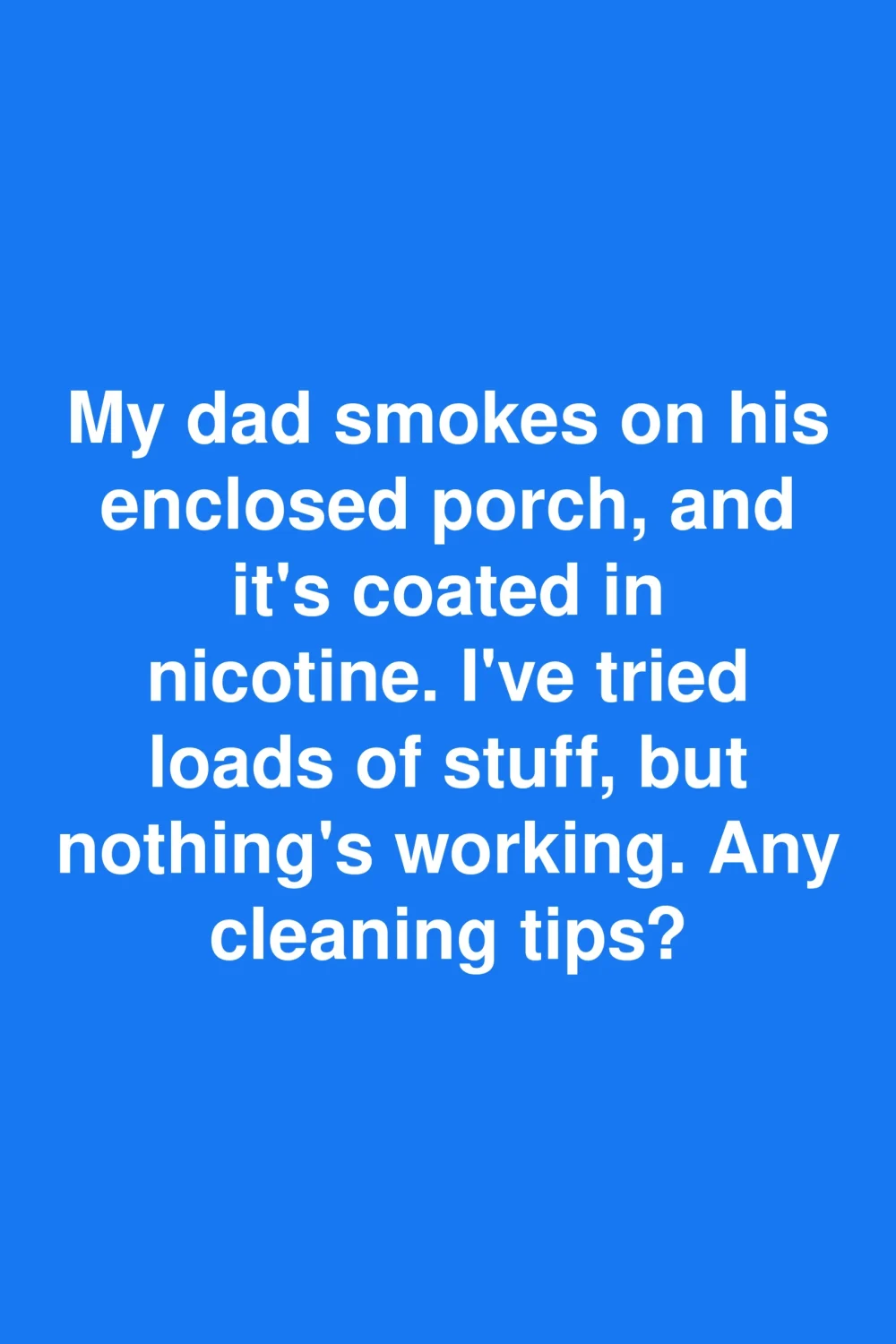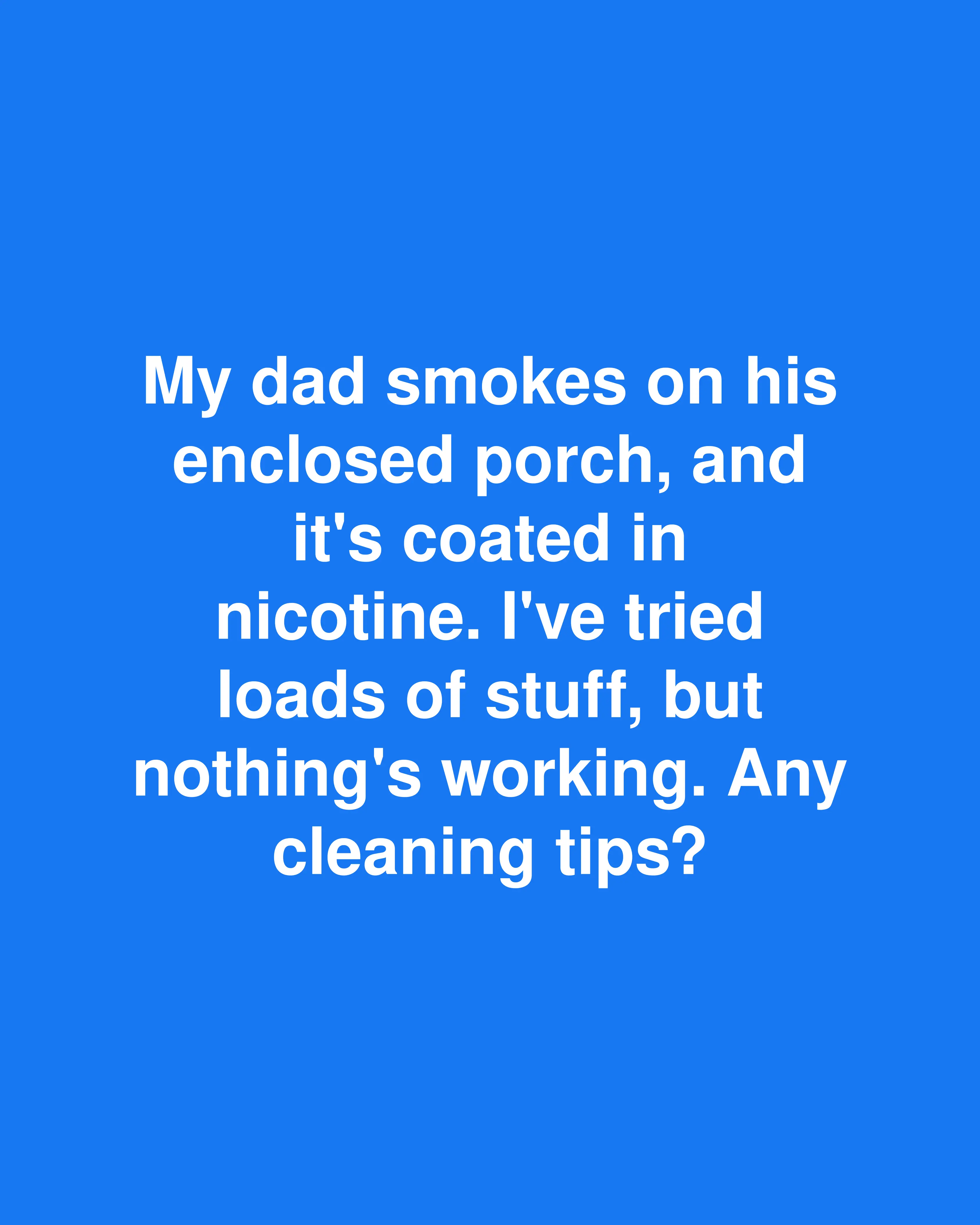Want to save this recipe?
Enter your email below and we’ll send the recipe straight to your inbox!
Banishing Nicotine Residue: The Ultimate Guide to Cleaning Your Enclosed Porch
Have you ever walked into an enclosed porch and immediately noticed that unmistakable yellowish tint on the walls and the lingering smell of cigarettes? Nicotine residue is notoriously stubborn, creating not just an eyesore but potentially affecting your health and the overall enjoyment of your space. Whether you’re dealing with the aftermath of a smoking tenant or helping a family member reclaim their porch, this guide will walk you through proven methods to transform that sticky, discolored space back to its fresh, inviting state.
Understanding the Nicotine Challenge
Nicotine residue isn’t just a surface-level problem. This sticky substance penetrates deeply into porous materials and forms a bond that becomes more stubborn over time. In enclosed spaces with limited ventilation, the concentration becomes even more intense, creating that characteristic amber film on walls, ceilings, and furniture.
The challenge goes beyond appearances. This residue contains third-hand smoke chemicals that continue to release toxins into the air long after the smoking has stopped. Studies from the Mayo Clinic suggest these lingering particles can pose health risks, especially to children and those with respiratory sensitivities.
The Preparation Phase: Setting Yourself Up for Success
Clear the Space Completely
Remove every item from your porch—furniture, decorations, rugs, curtains, and anything else that can be moved. This gives you unobstructed access to all surfaces and prevents cross-contamination during cleaning.
Ventilation is Your Friend
Before you begin, open all windows and doors and set up fans to create airflow. This serves two purposes: it helps dissipate cleaning fumes and begins the air-clearing process. If possible, do this for 24 hours before starting your deep clean.
Gear Up Properly
Don’t underestimate the importance of proper protection:
- Rubber gloves (nicotine can absorb through skin)
- Eye protection
- Mask or respirator (especially important for those with sensitivities)
- Clothes you don’t mind getting dirty
Effective Cleaning Solutions: What Actually Works
The TSP Method
Trisodium phosphate (TSP) is often considered the gold standard for nicotine removal. This powerful cleaner breaks down the tar and nicotine bonds that other cleaners can’t touch.
- Mix 1/4 cup of TSP with one gallon of warm water
- Apply with a sponge to walls, ceilings, and hard surfaces
- Allow to sit for 5-10 minutes
- Scrub with a soft-bristled brush
- Rinse thoroughly with clean water
Safety note: TSP is powerful but caustic. Always wear gloves and eye protection, ensure good ventilation, and test on a small area first.
The Vinegar Solution
For those preferring a natural alternative:
- Mix equal parts white vinegar and warm water
- Add 1-2 tablespoons of dish soap
- Apply with a spray bottle or sponge
- Let sit for 10-15 minutes
- Scrub in circular motions
- Rinse and repeat as necessary
The acidity of vinegar helps break down nicotine while neutralizing odors. This method might require multiple applications but is gentler on surfaces and lungs.
The Ammonia Approach
For extremely stubborn residue:
- Mix one part ammonia with three parts warm water
- Apply to surfaces with a sponge (never use a spray bottle with ammonia)
- Allow to sit for 5 minutes
- Wipe clean with a damp cloth
- Rinse thoroughly
Important warning: Never mix ammonia with bleach or vinegar as this creates dangerous toxic gases. Ensure exceptional ventilation when working with ammonia.
Tackling Different Surfaces
Painted Walls and Ceilings
The most visible nicotine damage usually appears on walls and ceilings. After cleaning with your chosen solution:
- Rinse thoroughly with clean water
- Allow to dry completely
- Apply a stain-blocking primer like Kilz or Zinsser BIN
- Finish with a fresh coat of paint
The primer step is crucial—it seals in any residual nicotine and prevents it from bleeding through your new paint.
Wood Surfaces
For wooden trim, furniture, or paneling:
- Clean with a TSP solution using a soft brush
- Rinse and allow to dry
- For unpainted wood, consider using a mixture of equal parts linseed oil and turpentine to restore moisture
- For severe cases, light sanding followed by refinishing may be necessary
Fabric and Upholstery
Fabrics are particularly challenging as they absorb smoke deeply:
- Remove covers where possible and wash with a cup of white vinegar added to the detergent
- For non-removable upholstery, sprinkle with baking soda, let sit overnight, then vacuum thoroughly
- Follow with a fabric cleaner containing enzymes
- Consider steam cleaning as a final step
For severely affected items, professional cleaning or replacement might be your best option.
Common Mistakes to Avoid
Skipping the Primer Step
Many people clean walls thoroughly only to watch yellow stains reappear within weeks. This happens because nicotine can seep through new paint unless blocked by a specialized primer. Always use a stain-blocking primer after cleaning and before repainting.
Underestimating the Ceiling
Ceilings often contain the highest concentration of nicotine residue (smoke rises!), yet they’re frequently overlooked. Start your cleaning from the top down to prevent cleaned areas from being recontaminated.
Using Bleach as a First Choice
While bleach is a powerful disinfectant, it’s not particularly effective against nicotine and can actually set the stains in some cases. It’s better as a final disinfecting step after the nicotine has been removed.
Ignoring Air Ducts and Filters
If your enclosed porch connects to your home’s HVAC system, don’t forget to clean or replace air filters and consider professional duct cleaning to prevent recirculating nicotine particles.
Beyond Cleaning: Preventative Measures
Sealants and Protective Finishes
After your deep clean and any necessary repainting:
- Consider applying a clear polyurethane sealer to wood surfaces
- Use washable paint for walls to make future cleaning easier
- Treat fabric surfaces with stain repellents
Air Purification Solutions
Invest in an air purifier with a HEPA filter and activated carbon to capture remaining airborne particles. Run it continuously for at least a week after cleaning.
Odor Neutralizers
Place bowls of white vinegar, coffee grounds, or activated charcoal around the room for several days to absorb lingering odors. Commercial odor neutralizers containing enzymes can also be effective.
Quick Recap & Practical Conclusion
Tackling nicotine residue requires a systematic approach:
- Prepare the space by removing all items and ensuring good ventilation
- Choose the appropriate cleaning solution based on the severity of the residue
- Address different surfaces with targeted techniques
- Seal and prime surfaces before repainting
- Implement preventative measures to maintain your fresh space
While the process requires effort, the transformation is well worth it. Not only will you enjoy a visually appealing space, but you’ll also create a healthier environment free from the lingering effects of third-hand smoke.
Frequently Asked Questions
How long will the cleaning process take?
For an average-sized enclosed porch with moderate nicotine buildup, expect to spend a full weekend on the project. Severe cases might require multiple cleaning sessions over several days, plus drying time before painting.
Is it better to hire professionals or DIY?
For moderate cases, DIY cleaning is certainly feasible with the right products and techniques. However, for severe nicotine damage, especially if it’s been accumulating for years, professional services with industrial-strength equipment might be more effective and ultimately save you time and frustration.
Will the nicotine smell ever completely disappear?
Yes, with thorough cleaning, proper sealing, and air purification, the smell can be completely eliminated. The key is addressing all surfaces, including hidden areas like the inside of light fixtures, window tracks, and any textiles in the space.
How can I prevent nicotine buildup if someone still smokes in the space?
If smoking in the enclosed porch will continue, consider installing an exhaust fan, using washable slipcovers on furniture, implementing a regular cleaning schedule, and placing air purifiers in the space. Ultimately, the most effective prevention is to designate outdoor-only smoking areas.


